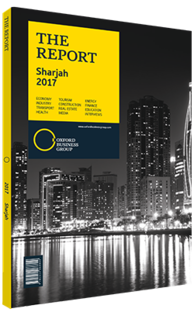Badr Jafar, CEO, Crescent Enterprises; and Executive Chairman, Gulftainer: Interview

Interview: Badr Jafar
What needs to be done to consolidate Sharjah as a regional logistics centre?
BADR JAFAR: There are two dimensions worth exploring here in Sharjah and in the broader UAE. The country enjoys a strategic location in the middle of the so-called new Silk Road, connecting the Far East and Central Asia with Europe and Africa. With this geographical advantage, its logistics sector has grown rapidly over the past few decades. Looking at Sharjah in particular, the emirate has always been an early pioneer in logistics, pioneering the land-sea-air concept. Sharjah opened the first international airport in the region in 1936, and established the Gulf region’s first seaport and the Middle East’s first container terminal, notwithstanding the opening of Khorfakkan in 1976 — the first port on the eastern coast and thus outside of Gulf waters. Other competitive advantages include Sharjah’s position as the only emirate in the UAE sharing borders with all six emirates other as well as Oman.
Despite these early achievements, one cannot help but feel that Sharjah has been losing its competitive edge in this sector over the years. However, the emirate’s business community, working alongside the local government, has an excellent opportunity to pick up that pioneering spirit again. This is particularly true in an era when the logistics industry is being disrupted by technology. On the one hand, new technologies have improved efficiency; but on the other hand, they are challenging the status quo and the “business as usual” approach. That represents a challenge to everybody, but also an excellent opportunity to those who get there first. For example, we now see established global players such as FedEx and UPS investing heavily in start-ups that are disrupting the existing logistics business model.
Infrastructure systems are living and breathing, and what happens over time is that if you do not maintain and rethink the systems themselves, you will find congestion becomes a major challenge to growth, and we have also seen this in Sharjah. The free zones in Sharjah were built for a smaller industrial landscape, and because small and medium-sized enterprises have thrived here over the decades, we are seeing increasing congestion, which hinders their ability to receive and send out goods. Other than improving road infrastructure, we need to see improved zoning of the city, which is something I am aware the government is working hard to deliver. Retroactive zoning is obviously more difficult than proactive zoning, so we need to think ahead on the use of spare land.
How has the recent decline in global trade affected cargo handling at Sharjah’s ports?
JAFAR: The whole region, and in fact all ports globally, had a tough year. Sharjah was no exception and experienced a 10% drop in volumes in 2016. A large percentage of volumes handled in Sharjah’s ports are trans-shipment, and those volumes tend to get hit first when you experience market consolidation. That said, our Sharjah-based management has made the most of the global slump by using the strategic advantage of Port Khorfakkan on the east coast of the Gulf. As shipping liners are striving to improve cost efficiencies, we provide them with the opportunity to offload trans-shipment cargo without having to go all the way down and around the peninsula.
There is no getting away from it. The shipping industry overbuilt capacity during buoyant economic times. However, over the last couple of years the large players in the sector have realised that strategy has not served them in an environment of more constrained growth, and so they are either banding together or dying out, which is why you are seeing these super-consortia being created. The knock-on effect is that shipping liners are trying to pass that pain onto port operators through rate reductions. The problem we are currently facing is that many of these ports are already overextended because of the massive investments that were made in order to build facilities to receive these huge vessels.
You have reached the limit of premium articles you can view for free.
Choose from the options below to purchase print or digital editions of our Reports. You can also purchase a website subscription giving you unlimited access to all of our Reports online for 12 months.
If you have already purchased this Report or have a website subscription, please login to continue.

